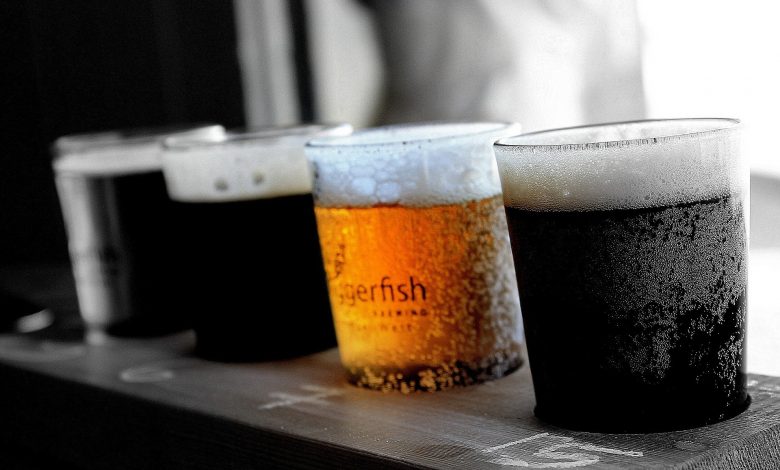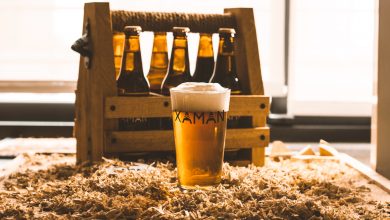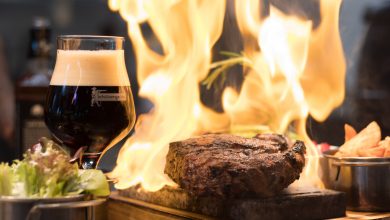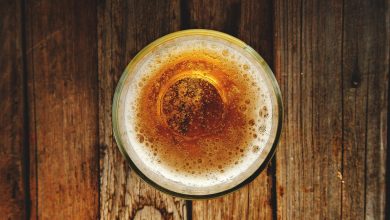The Chemistry Behind Beer: What’s In It & What Gives It That Unique Flavor?

Beer is one of the world’s most commonly used and widely consumed alcoholic beverages. It is a complicated alcoholic drink that contains numerous taste-active compounds over a broad range of levels. The beer flavor is a fine balancing act among all the ingredients, and it is a struggle for brewers to manufacture their products with taste consistency and retain the balance of flavor for as long as needed.
A Brief History of Beer
Earlier-time brewing attempts took place around 7000 B.C. in Mesopotamia. The Greeks and Egyptians also used different methods to brew alcoholic beverages, but in these early translations, the term “beer” did not appear. The Babylonians provided recipes for brewing, and the Bible contains multiple references to beer.
The English word “beer” does seem to originate from the Celtic word “beor,” which alluded to a monk-made malt brew at a monastery in North Gaul. Monasteries were the prominent beer producers in the Middle Ages, and several early brewing methods have been attributed to the work of monks, including adding hops to enhance the beer’s aroma and help maintain it.
During the 13th century, the distinction between lagers, ales, and darker bock beers appeared in French and Irish writings. The first beers, as we know them today, are generally accepted to date back to the 1600s. European immigrants introduced their expertise in brewing to America and established a flourishing beer industry. Many advances in technology, such as the yeast separator, made mass beer production possible, and in the 1930s, canned beer first appeared on the market.

Key Ingredients and Raw Materials
The brewing process requires four main ingredients: malt, hops, water, and yeast. Each component may affect the beer’s flavor, alcohol content, color, carbonation, and other subtle changes. Approximately 35 pounds (16 kg) of barley malt and 15 pounds (7 kg) of grain are used for making every 31-gallon beer barrel.
Malt
Malted barley is by far the most common source of malt in beer, but some brewers may also use oats, wheat, rye, rice, or maize. Malted barley is just barley grains that have been soaked in water before they start to sprout, which then serves as a source of fermentable sugar, a very necessary yeast food, and gives the final product a little sweetness. Different flavors can be created utilizing different malt sources.
Yeast
Yeast is the key component responsible for two big beer indicators: alcohol and carbonation. Beer yeast has two major types – ale yeast and lager yeast. To turn the wort into alcohol, yeast is required. Yeast eats the wort’s simple sugars, while the fermentation process goes on and continues to turn them into carbon dioxide and alcohol.
Hops
Hops are cone-shaped flowers that can change and impact the beer’s flavor and aroma. While the primary fermentation occurs, hops are used to counteract and balance the sweetness of the malt. Adding more hops increases the bitterness of the beer.
Water
Water accounts for about 90 percent of the content of beer. Different water characteristics, like the pH level, mineral content, whether it’s chlorinated or not, and if it’s hard or soft water, have to be considered. Hard water includes a variety of minerals, whereas soft water contains sodium because it is just ion. Water must be chlorine-free and free of other harmful chemicals, but quantities of minerals must still be present for the process of fermentation and to ensure the feeding of yeast.
Other Ingredients
While these four are the standard beer ingredients, spices, fruits, and herbs may also be added to these ingredients for the purpose of creating several unique aromas and flavors of the beer.
The method also requires different acids and chemicals for cleaning to preserve and sanitize the brewing equipment. Also required for the end-product is packaging, which involves cardboard products for boxes, glass for bottles, aluminum for cans, and stainless steel for kegs and other commercial dispensing devices. Most of the equipment for brewing is stainless steel, apart from copper brew kettles that are also used sometimes.

The Science of the Brewing Process
It’s easy to overlook the scientific process involved in beer making when you’re just trying to relax and enjoy your beer in peace. Science, in fact, may be the last thing on your mind. It is, however, interesting to know what goes into the entire process of brewing that allows us to sit back, relax, and enjoy our beers. Here’s a breakdown of the science involved in the process of beer brewing.
Malting
Fully mature grains of barley are soaked in cold water until completely saturated. The water is modified once daily, and the grains are stored in shallow tanks after 45 – 72 hours. The grain is then oxygenated and stirred, following which, they germinate, leading to the release of enzymes like malt diastase. For fermentation, malt diastase transforms the starches in the grain into sugar. It normally takes six days for the germination process to occur, and then the grain undergoes roasting to stop the process of germination. The specific point at which the roasting begins and ends influences the beer’s taste and color. The end-product of this step is called malt.
Mashing
Through the use of iron rollers, malt is smashed and transferred to the mash tank, which is a large vessel of stainless steel or copper that combines the malt and warm water until it has a consistency similar to porridge- the combination is called mash. After mixing, the mash temperature gradually rises from 100 – 170 degrees F (38 – 77 degrees C) to cause a reaction of the enzymes that break down and convert the grain’s starch into simple sugars. Once accomplished, the mash is required to sit untouched so that the solids can go down to the tank’s bottom.
Lautering and Brewing
The mash’s liquid is moved to yet another tank termed as lauter tun by drawing out the liquid through the mash solids bottom layer, which serves as a filter. To clean the remainder of the liquid, now termed wort, from the mixture, hot water is applied to the mash tank’s top. The wort then goes to the kettles for brewing, where it is heated to sanitize it, and the prepared hops added. Including the hops is critical, as they add to the beer’s bitterness. The final wort is once again filtered after completion of the brewing and pumped into the fermentation tanks.
Fermentation
The environment should be strictly regulated in the fermentation tanks to deter any bad bacteria from meddling with the yeast. Carefully managed yeast (about one pound per barrel of wort) is introduced to the wort, and the mixture’s temperature is steadily lowered to between 50 degrees F and 60°F (10 – 15 degrees C) over a few days. The yeast develops in this range of temperatures, absorbing the sugar in the wort, and creating carbon dioxide bubbles, by which time, the wort has turned into beer. The beer produced is filtered again and moved to the aging barrels under a controlled temperature of 33 degrees F for 2 – 24 weeks. The specifics of this process include the following steps:
- The step of the lag: The yeast starts to consume oxygen immediately. Enzymes promote the absorption of glucose and nutrients by the yeast in a couple of hours.
- Breathing and fermentation phase: The yeast continues to replicate with ample food resources and consumes the wort’s leftover oxygen, using this and other nutrients to create new “daughter” cells. After the absorption of all oxygen, reproduction ceases, and proper fermentation starts. To put it simply, yeast transforms one glucose molecule into two ethyl alcohol molecules and carbon dioxide.
- Clarification and carbonation: Following ingestion of all available fermentable sugars, fermentation is halted, and the yeast starts to fall back into a dormant state. In a cool, calm, protected environment, the beer is then clarified and becomes flat, being clear of any clouding agent. The enormous amount of carbon dioxide created throughout this fermentation process is allowed to escape via a gas vent, whereas the alcohol is stored in a sealed environment.
Pasteurization
The beer may be pasteurized after it has aged to destroy the surviving yeast and avoid further production of alcohol. Heating of the beer past 135 degrees F (57 degrees C) will achieve this; however, pasteurization is not used in genuine draft beer production. Such beers are regarded as “ice” beers because they need to be kept in the fridge to maintain their flavor and slow down the remaining activity of the yeast. The draft beers are considered by many to be the best in aroma and taste.
Packaging
Packaging plays an important role in maintaining beer quality too. Regardless of whether packed in cans, kegs, or bottles, the beer is delicately shifted in the bottling area through the piping labyrinth to maintain the natural carbonation. While bottling, the fermentation kettles utilize extra carbon dioxide to improve the beer’s aroma.

Secrets to the Unique Flavor of Beer
All the ingredients that go into the brewing of beer are responsible for contributing to its unique flavor and are briefly discussed here.
Malt and Grain Bill
The unique flavor of the beer is influenced by the malt used and grain bill, that is, the quantity of grains used in the process of beer brewing. Some grains are used as enhancers for the beer body and add different flavors to the beer. For example, wheat malt will contribute to a ‘bready’ beer flavor, while crystal malts result in greater final gravity, a candy-like sweetness, and changed beer color. Rye malt can give the beer a powerful spicy flavor.
Yeast
Alcohol and other by-products termed esters are produced as yeast ferments sugars, and these can have a mild fruitiness, or under high temperatures, they can give off a taste similar to nail polish removers. The attenuation number of yeast chosen indicates how much of the sugar will be fermented to form alcohol. Beers with high alcohol content also have a pleasant warming taste, if the body can support it, but beers with a rather high ABV can taste off-balance in a low body beer.
Water
Water chemistry impacts beer flavor. Factors like the mineral content, pH level, hard/soft, and chlorinated/not chlorinated status of water will affect the flavor of the beer ultimately. A cherry medicine-like flavor can result from chlorophenols if the water used contains chlorine. You may also end-up with bitter tannins and reduced beer flavor or aroma if the pH is very high.
Hops
Hops contribute bitterness to provide a balance to the sugar-sweet malt and provide flavor and aroma to beer based on when they are added. Four major types of compounds present in hops that add to the flavor of beer are:
- Alpha acids – Alpha acids break down into iso-alpha acids in the brewing process. These are soluble compounds that contribute to the beer’s bitter flavor, with humulone being the strongest alpha acid in most hops.
- Beta acids – Beta acids are much stronger in bitterness than alpha acids, but they make less of a contribution to the beer’s flavor, as they are insoluble.
- Essential oils – Natural hop oils provide most of the beer’s flavor and aroma, with humulene providing most of the essential oils that give beer its distinctive hoppy scent. American hops have greater amounts of myrcene, which gives the flavor of citrus or pine.
- Esters – In beers, esters add fruity flavors. While brewing, the ultimate ester concentration in beer is dependent on pH, mixture agitation, and temperature.
First wort hopping, if used, adds a huge quantity of hops to the boil kettle as soon as it receives the wort from the lauter tun. This ends up increasing the overall level of bitterness of the beer. Obtaining a pleasant flavoring is possible by the addition of hops in the middle of boiling. If added when the boiling is almost over, a greater quantity of hop aroma is maintained due to reduced loss of the aromatic hop oils. Dry hopping also increases hop aroma by the addition of hops to the fermenter.

Signature Flavors of Beer
A variety of combinations of the ingredients added during the brewing process can produce a range of flavors that contribute to its unique taste. Seven such signature beer flavors obtained through the process of brewing are given below:
Crisp
Crisp beers are characterized to be lighter, refreshing, and cleaner in terms of their flavors. They vary from straw to amber in terms of color, have low to medium ABVs, and the body of such beers are light to medium.
Hop
Such brews are more about the delightful aromas, as well as marked bitterness resulting from generous hop additions. Although generally imbued with some richness of malt, it is the hops in such brews that will always contribute the most to the flavor. Such beers vary in color from yellow to brown, in the body – from medium to full body, and have low to high ABVs.
Malt
The flavor profiles of some brews are dominated by malt-driven flavors; a level of sweetness and strong malty notes of caramel, fruit, nuts, toast, and toffee are to be expected in such brews. Such beers vary in color from copper to dark brown, in the body – from light to full, and in ABV levels from low to high-level ABVs.
Roast
For the purpose of obtaining coffee and cocoa flavors, richness of mouthfeel, and also very dark appearances, some brews make use of heavily roasted malt grains. These brews can range from deep copper to black in terms of their color, with low to high ABV content. In terms of the body, they can vary from medium-light to full-body brews.
Smoke
Brews incorporating malts smoked over different wood fires are referred to by the smoke category of beer flavors. Such beers vary in terms of the body from medium to full body, maybe colored deep amber to dark brown, and can be medium to medium-high in ABV levels. They are generally brews of a milder nature, but the smoky flavors can sometimes add a dramatic effect to the flavors.
Fruit and Spice
These beers’ flavor compositions are most noteworthy for their strong fruit and spice flavors, with fruits and spices being added sometimes with the objective of helping to accentuate these flavors further. Such brews could be sweet, semi-dry, or even dry, but they never have an overt bitterness. ABV levels vary from low to high, golden to dark brown variations of color are available, and low to high body variants exist.
Tart and Funky
These are the rustic, earthy, and winey flavors of sour brews. Some of these are quite light and delicately acidic; some are darker and more acidic, while others are extremely sour and wacky. These beers can vary in color from straw-colored to dark brown and can be light to medium-full in the body. They may have exceptionally low ABV levels or even very high ABV levels.



